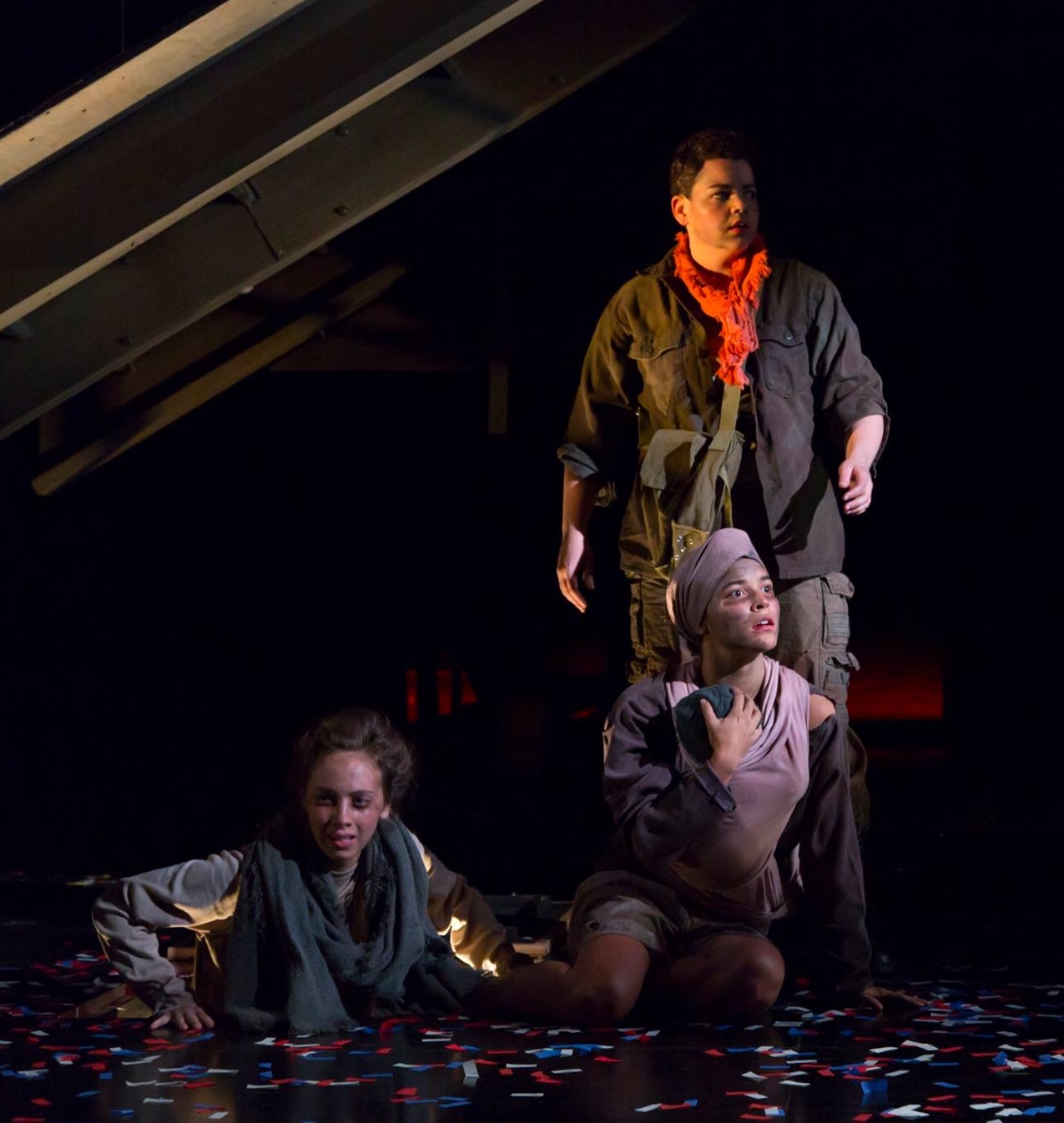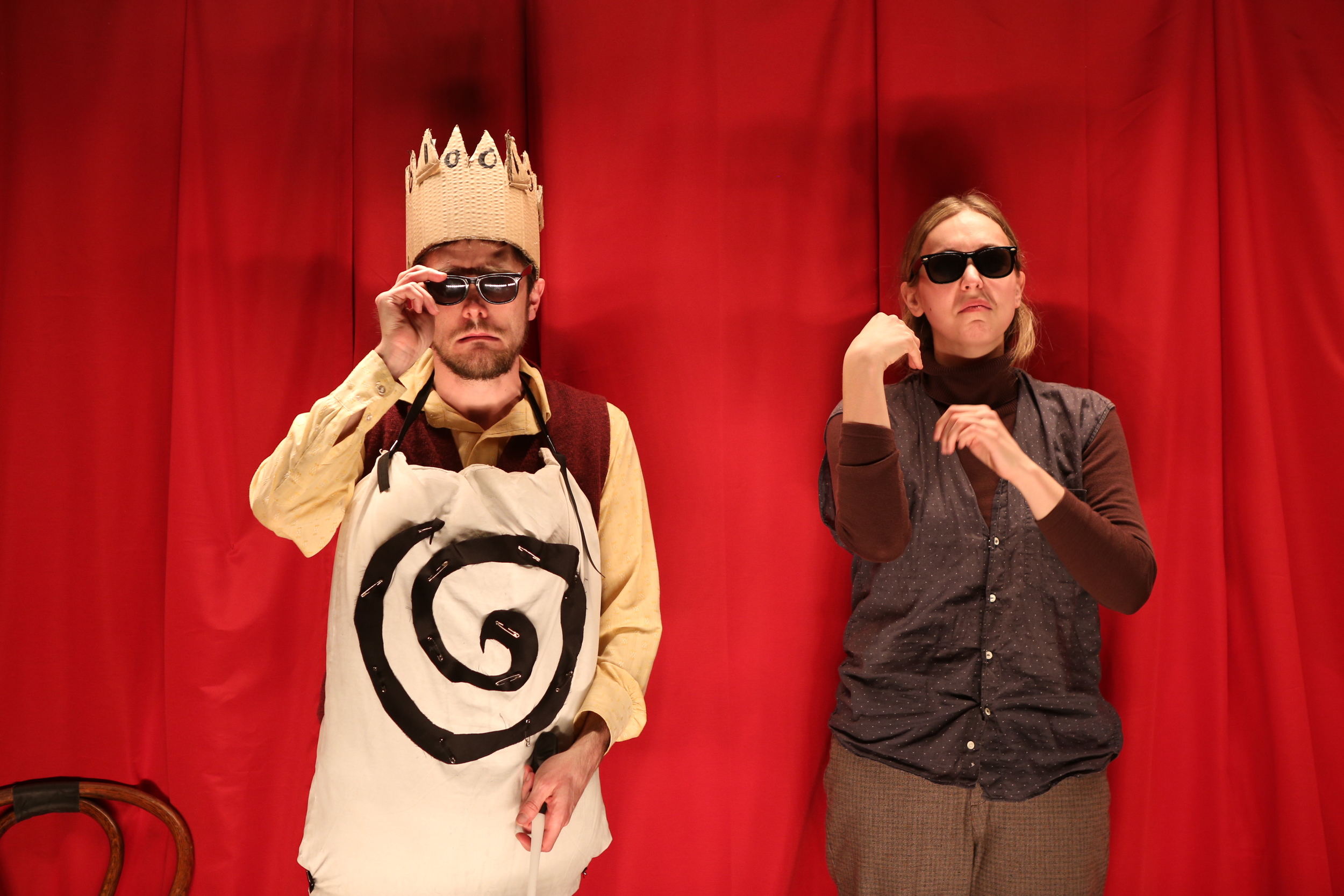Review of The Skin of Our Teeth, Yale School of Drama
Thornton Wilder’s Pulitzer-winning play The Skin of Our Teeth, like his better-known Pulitzer-winning Our Town, has its way with the conventions of theater, and both do so in the name of what Wilder views as a focus on the human condition sub specie aeternitatis. To help us understand our condition, it’s important that we get a handle on the many ways we let “play-acting,” at all levels, define us. Like Our Town, The Skin of Our Teeth winks at us throughout. Suitable for a tale of life, marriage, death in Everytown, America, perhaps, the twinkle gets more than a bit long in the tooth in a tale that’s supposed to be taking on less “natural” matters such as human extinction, political chicanery, war, and global apocalypse.
In the Yale School of Drama thesis show directed by Luke Harlan, The Skin becomes a factory of creative approaches to theater and a showcase for how malleable and enduring certain conventions remain, perhaps eternally so.
The play begins, as many family-centered dramas do, in sit-com mode. Wilder’s writing style throughout the play recalls burlesque—the characters don’t speak to each other so much as proclaim at each other—and the tone easily adapts to a topsy-turvy “typical” middle-class home during the Ice Age, with dinosaurs as pets (cf. The Flintstones). Harlan’s cast keeps it cartoonish, with Andrew Burnap manic as pater familias George Antrobus, a kid-slapping, bossy caricature of the man-of-the-house c. 1940; he’s also inventing the alphabet and the wheel (though there’s a bicycle onstage at one point). His wife, Maggie (Baize Buzan, perfectly cast), is a can-do homemaker with more resources than we might expect; they have two children: Henry, aka Cain, (Aubie Merrylees) is the potentially violent psycho-in-the-bud with which we have become all-too-familiar in recent years, and Gladys (Juliana Canfield), a daddy’s girl, with all that might suggest, appropriate and otherwise. They had another child, but, thanks to Cain, there’s only the two now.
front: Baize Buzan (Maggie), Andrew Burnap (George), Juliana Canfield (Gladys); rear: Aubie Merrylees (Henry)
In the midst of the family dynamic is the maid Lily Sabina (as in “rape of the Sabine women”), played by Melanie Field with permutations that deserve their own paragraph. She starts as a kind of “everywoman scullery maid” and swiftly becomes a working-girl voice of protest against the play (her soliloquy, ad-libbed into the text, as she smokes a theater cigarette at the Exit door, venting against YSD and New Haven, is the funniest speech in the whole play). Later, she’s a Betty-Booped caricature of a man-eating bombshell, and a Ethel Mermaning Statue of Liberty for the big Atlantic City production number. In the final act, she becomes a female soldier who helps the family pull through. Throughout she remains some version of Lily Sabina, intrepid underling, which is to say that Wilder knows the stage requires stereotypes the way the Unconscious requires archetypes. So reJoyce, for the Twain do meet.
Andrew Burnap (George Antrobus), Melanie Field (Lily Sabina)
From anxious sit-com we go to Broadway glitz and the show-biz of politics, as Antrobus seeks public office—with the ever-recurring leer at marital infidelity the thorn in the side of the upstanding leader—to the bombed-out aftermath of war that recalls Beckett and Brecht and the theater of scarcity, kept light by an intrusion, early in Act III, by the Theater Manager (Harlan) as he tries to deal with cast members fallen ill due to food poisoning (extra credit to Harlan for playing “himself” as distracted director).
Anna Crivelli, Dylan Frederick, Melanie Field, Ricardo Davila, Annelise Lawson
Whatever you make of the play, the production values here are top notch. There’s a big musical number via Christopher Ross-Ewart that plays well after the intermission, while we’re still being entertained, and a haunting song sung by the refugees. Harlan and Scenic Designer Choul Lee use below-stage at the Rep to create an Atlantic City boardwalk effect, and the bombed-out house of Act III has, oddly, more reality than the homey house of Act I. There are numerous cast members that barely get a moment to register in roles as refugees and chair-pushers; it’s as if Wilder wants bodies onstage but doesn’t want to bother with them as characters. At least Harlan and choreographer Gretchen Wright give some—Anna Crivelli, Annelise Lawson, Dylan Frederick, Ricardo Dávila—as dancers something to do, and that helps. An exception to the under-scripting is Paul Stillman Cooper, almost unrecognizable as the prognosticating coin-operated psychic in a box, once a staple on boardwalks on the Eastern shore. Cooper makes an interesting speech about not being able to predict the past that gets under the skin of The Skin of Our Teeth.
Paul Stillman Cooper (Fortune Teller)
Still more profound is the final showdown between George and Henry or the eternal battle between Father and Son. Before anyone had coined the term “generation gap,” the Oedipal drama had become archetypal by way of Sophocles, Shakespeare and Freud, to name a few; Harlan’s production lets us see the struggle—as I read it anyway—as very much a part of the post WW2 world so many things we know date from—like the Bomb, rock’n’roll, and the TV ads Rasean Davonte Johnson’s wonderful wartime ad projections remind us of. Merrylees’s Henry, who is supposed to sound evil and nihilistic (in Wilder’s conception), like Cain, a blow against all the good Wilder, in the midst of the war, wants to believe in, sounds to me like a frantic child born into the Atomic Age and given a gun to play with, like all those daddies had in the war. In other words, Wilder wants us to consider personal resentments and the existential battle against God’s big plan, but times change, even for a play that plays forever, and the YSD show lets us consider Wilder in his time, foretelling our past.
Aubie Merrylees (Henry/Cain)
With references to extinction via a flood, the senseless killing of a black worker, and the needs of refugees at the door of our collective comfortable domicile, The Skin of Our Teeth could bite harder at our current state of the world, but Wilder wants us to find succor, as George does, in Spinoza, Plato and Genesis, and that, in our era, feels quaint. Rather than the light of humanism shining on, George seems a fuddy-dud who will never get around to reading Maggie’s missive in a bottle.
front: Baize Buzan (Maggie), Juliana Canfield (Gladys); rear: Melanie Field (Lily Sabina)
Yale School of Drama presents
The Skin of Our Teeth
By Thornton Wilder
Directed by Luke Harlan
Choreographer: Gretchen Wright; Scenic Designer: Choul Lee; Costume Designer: Haydee Zelideth; Lighting Designer: Carolina Ortiz-Herrera; Sound Designer/Original Music: Christopher Ross-Ewart; Projection Designer: Rasean Davonte Johnson; Production Dramaturg: David Clauson; Stage Manager: Paula Renee Clarkson
Cast: Andrew Burnap; Baize Buzan; Alex Cadena; Juliana Canfield; Paul Stillman Cooper; Anna Crivelli; Ricardo Dávila; Melanie Field; Dylan Fredercick; Rebecca Hampe; Luke Harlan; Annelise Lawson; Jonathan Majors; Aubie Merrylees; Jennifer Schmidt; Shaunette Renée Wilson
Yale Repertory Theatre
October 20-24, 2015











